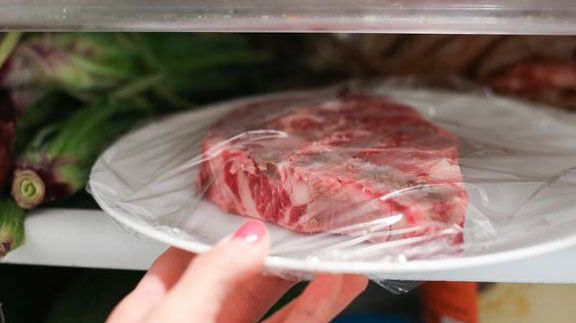Country Lifestyles
[AgriLife Today] Expert: Spring right time to ‘chill-out’ with food safety

By: Paul Schattenberg
Make cleaning fridge part of spring cleaning ritual
KERRVILLE – As the “home” for raw and cooked foods, the refrigerator is both a useful and vital appliance that must be kept clean to reduce the risk of foodborne illness, said a Texas A&M AgriLife Extension Service expert.
With spring just around the corner, now is the perfect time to be thinking about cleaning the refrigerator and making it as safe as possible for food storage, said Rebecca Dittmar, Agrilife Extension program food safety management specialist based in Kerrville.
A National Sanitation Foundation study in which microbiologists measured levels of yeast, mold, staph and coliform bacteria — the family that includes salmonella and E coli – determined the kitchen was the “germiest” room in the house. It was also the room with the most coliform bacteria.
“Bacteria was found on multiple surfaces, including sponges, sinks, countertops and cutting boards,” Dittmar said. “This really drives home the need to keep kitchen surfaces, including refrigerator surfaces, as free from bacteria as possible,” Dittmar said.
But cleaning the fridge isn’t as simple as cleaning other areas of the kitchen, she noted.
“First of all, harsh chemicals and disinfectants like bleach shouldn’t be used to clean surfaces where you will be putting food,” she said. “Disinfectants that come into contact with food could make you sick due to the strong chemicals they contain. It’s best to use hot, soapy water to clean the refrigerator — or use specially formulated products or natural cleaners.”
According to the U.S. Department of Agriculture’s Food Safety and Inspection Service, the two families of bacteria that can be found in refrigerators are pathogenic bacteria, which cause foodborne illness, and spoilage bacteria, which cause foods to deteriorate and develop unpleasant odors, tastes, and textures.
“This is a good time to use or throw away foods that are close to reaching their expiration date or spoiling,” she said. “Obviously, before cleaning the interior of the fridge you’ll want remove all the food. An empty fridge makes cleaning easier and pretty much eliminates the possibility of contamination.
“Take out all the removable parts, such as shelves and drawers and put these in the sink to soak with warm water and regular dishwashing soap before rinsing and drying. You may want to let any glass or ceramic pieces warm up a bit before putting them in hot water to avoid their cracking or breaking from ‘thermal shock.’”
Dittmar suggested wiping the interior surface area with commercial wipes or dishwashing soap and warm water, working from top to bottom to avoid drips onto clean surfaces.
“Use a dishcloth or a paper towel when cleaning,” she said. “To remove tough stains, mix some baking soda with water to make a paste and apply it to the stain and let it sit for a while before scrubbing and wiping it off. For thick or sticky spills, you may want to put a warm, wet cloth over the spill for a few minutes to soften them and make them easier to remove. If you used the dishcloth to wipe up raw meat or juices, wash it or replace it immediately with a clean one.”
She said while cleaning pay particular attention to any corners, cracks and crevices where spills and small particles of food typically collect, and remember to wipe down interior doors.
“Once the interior is clean, it’s time to put the food back into the refrigerator,” Dittmar said. “Make sure the interior temperature is set to keep foods below 40 degrees Fahrenheit. Once the fridge is clean, commit to take extra measures to keep it that way. Regularly look for hidden spills and wipe up any new spills immediately. Remove any foods that produce lingering odors, and to keep the fridge smelling fresh, put an open box of baking soda on one of the shelves.”
She said this is also a good time to start developing the habit of each week throwing out perishable foods that should no longer be eaten.
“A general rule of thumb for refrigerator storage for cooked leftovers is four days,” she said. “If food is past its ‘use by’ date, it’s usually best to discard it. If you’re not sure or if the food looks questionable, the maxim ‘When in doubt, throw it out’ is a good way to go.”
For more specific guidelines for the length of time certain foods should be kept in a refrigerator, go to http://www.fsis.usda.gov/shared/PDF/Refrigeration_and_Food_Safety.pdf .
Dittmar said any food that looks or smells suspicious should be thrown out, and items such as ketchup and mayonnaise should be refrigerated after opening.
She also said raw meat, poultry and seafood should be kept in a sealed container or securely wrapped so their juices do not contaminate other foods. She said large amounts of foods such as stews or soups should be divided into smaller portions and put in containers for refrigeration, and the same for large portions of meat or poultry.
“When you’re returning foods to the fridge, this is also a good time to wipe any crust or sticky residue off jars or containers and dry them,” she said. “Food in the refrigerator should be covered to retain moisture and prevent it from picking up odors from other foods. And eggs should not be stored on the door of the fridge, but rather in their carton and on a shelf, as the door temperature is less consistent.”
-30-
LikeTweet
Find more stories, photos, videos and audio at http://today.agrilife.org
Country Lifestyles
A Mountain Out of a Molehill

By Nicholas Waters
As winter plods along – come Spring and gopher mounds – homeowners and farmers find themselves playing a familiar song – fiddling while Rome is burning.
Let’s make a mountain out of a molehill. Those mounds on your lawn and pasture could be moles, but they’re more than likely gophers; Plains Pocket Gophers to be pragmatic – Geomys bursarius to be scientific.
These rodents dig and chew, and the damage they can do goes beyond the mounds we mow over. Iowa State University cited a study in Nebraska showing a 35 percent loss in irrigated alfalfa fields due to the presence of pocket gophers; the number jumped to 46 percent in decreased production of non-irrigated alfalfa fields.
The internet is replete with academic research from coast-to-coast on how to curtail gopher populations, or at least control them. Kansas State University – then called Kansas State Agricultural College – also published a book [Bulletin 152] in February 1908 focused exclusively on the pocket gopher.
To read more, pick up a copy of the April issue of NTFR magazine. To subscribe by mail, call 940-872-5922.
Country Lifestyles
When A City Girl Goes Country

By Annette Bridges
Everyone needs a room with a view that makes their heart happy. My honest favorite panorama would be either the mountains or the ocean. I have yet to convince my hubby to make permanent moves to either, although he does enjoy the visits as much as I do.
The location of our house on our ranch does not provide the expansive field of vision of our land that I would enjoy. So, I have created a room decorated and furnished in a way that gives me smiles, giggles, and a wonderful peace-filled feeling when I am hanging out in it. I am in that place right now writing this column. I am in a lounging position with my computer in my lap on the chaise that was once my sweet mama’s. I had it reupholstered this year to give it a fresh look.
To read more, pick up a copy of the April issue of NTFR magazine. To subscribe by mail, call 940-872-5922.
Country Lifestyles
On the Road with Dave Alexander

Local celebrity dancers of the greater Gainesville area brought the house down recently at the second annual “Dancing With Our Stars” contest in Lindsay. The event raised more than $200,000 as the sponsored dance teams did their best to take home the grand prize.
The money raised will go to the “Heart of NTMC” Campaign for the purchase of a cardiac capable CT machine for the Gainesville hospital. Rodolfo “Rudy” Martinez and Sherry Sherriden took home the Mirror Ball Trophy.
To read more, pick up a copy of the April issue of NTFR magazine. To subscribe by mail, call 940-872-5922.
-

 Country Lifestyles1 year ago
Country Lifestyles1 year agoScott & Stacey Schumacher: A Growth Mindset
-

 Equine7 months ago
Equine7 months agoThe Will to Win
-

 Country Lifestyles7 years ago
Country Lifestyles7 years agoStyle Your Profile – What your style cowboy hat says about you and new trends in 2017
-

 Country Lifestyles4 years ago
Country Lifestyles4 years agoAmber Crawford, Breakaway Roper
-

 HOME7 years ago
HOME7 years agoGrazing North Texas – Wilman Lovegrass
-

 Country Lifestyles7 years ago
Country Lifestyles7 years agoDecember 2016 Profile, Rusty Riddle – The Riddle Way
-

 Country Lifestyles8 years ago
Country Lifestyles8 years agoJune 2016 Profile – The man behind the mic: Bob Tallman
-

 Country Lifestyles8 years ago
Country Lifestyles8 years agoCowboy Culture with Clay Reid – Being a Man






